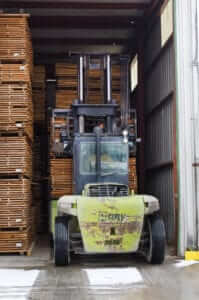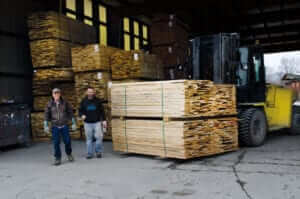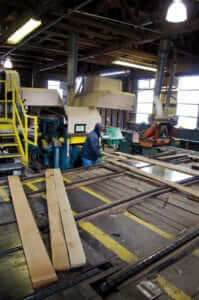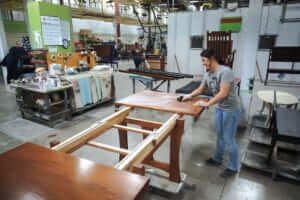From the woods to the sawmill, lumber yard, trucking company, and local retailers, Gat Creek’s story has its roots in West Virginia–but its branches stretch across the world.
Matt Muck admits it—he’s not a good salesman. He doesn’t dress the part, for one thing. No matter the weather, he always wears cargo shorts and running shoes.
When customers come into Colonial Interiors, his family’s 38-year-old furniture business in St. Albans, Muck does not meet them with high-pressure sales pitches. He does not follow them around the store. Muck prefers to let the furniture do the talking. That’s one reason the store carries Gat Creek furniture. Every table, chair, and chest of drawers has a story to tell.

That local connection has inspired a dedicated following for Gat Creek furniture. When Rick McEwuen at Chuck’s Furniture and Mattress in Morgantown points customers toward Gat Creek products, ”I tell them it is made in West Virginia by West Virginians. Not only is it well-designed and well-made, all the lumber comes from local hardwoods and keeps our West Virginia people working.”
McEwuen also appreciates that Gat Creek will customize just about any piece to a buyer’s specific requirements. “They can make a table taller or shorter, or if you need a casegood in a slightly different size, they can accommodate you,” he says.
All the company’s models are also available in a variety of woods and finishes. Delivery usually takes one or two months for these custom jobs, but while customers are waiting, each receives an orange postcard in the mail.
On one side is the name and sepia-toned photo of a Gat Creek furniture builder. On the reverse, there’s a short biography of the builder along with a handwritten message, thanking the customer for their order and letting them know their furniture will soon be on its way. When their order arrives, that same builder’s signature will be on the back, along with the date the furniture was completed. “It puts a name and a face with the piece,” Muck says.
Those postcards do not tell the complete history of the furniture, however. Each Gat Creek creation is a collaboration between dozens of West Virginia men and women representing deeply rooted, family-owned businesses.
•
Hunter Smallridge can tell a lot, just from looking at a tree. After a lifetime hanging around Smallridge Timber, the Buckhannon logging business his father founded in 1992, he can tell if a tree is ready to be harvested. “They’re like humans. They’ve got a prime. And they get old, too, just like us.”
He can estimate how much sawn lumber a tree will produce. “You can look and say, that’s got 300 board feet in it, or, that one’s got 200 board feet in it,” he says. “You can just tell, after you’ve done it long enough.” And, since he knows he’ll receive 60 cents per board foot once the tree is sold to a sawmill, Smallridge can accurately estimate how much profit he will make.
Smallridge sometimes buys tracts of timber from bid sales, where a forester has already identified the trees to be cut and estimated the board footage. But he usually prefers to find his own timber. He’ll walk the land with the owner, look over the trees, make a plan for how he will get his equipment and crews in place, and make an offer.

The company has four log crews, each made up of four people. “The loader man, the skidder man, the dozer man, and the timber cutter,” Smallridge says. “Everybody just works together. Most of my men can do every job out there.”
On a recent big job, Hunter’s cousin Shawn Smallridge served as the bulldozer operator. He started by preparing a staging area where the crew would work and cutting access roads to the stands of timber. He also moved brush to give the timber cutter, cousin Timmy Smallridge, easier access to the trees.
Timmy fells a tree by cutting a wedge-shaped notch in the side, pointing in the direction he wants it to fall. He then makes a bore cut, putting the chainsaw straight into the tree a few inches behind the notch. This creates a hinge, which will drop the tree slowly and accurately. He next slices into the backside of the tree until the saw reaches the bore cut—and then runs out of the way as quickly as possible. If the hinge cut is executed properly, he will be well out of danger before the tree even begins to move.
Once the tree crashes to the ground, Timmy uses his saw to take off all the branches along with any part of the trunk that’s smaller than three inches in diameter. Some of this waste is hauled off and made into chipboard. Smallridge’s crews leave some brush behind to serve as cover for new growth. “That protects it from getting eaten off by deer,” he says.
Dozer operator Shawn moves downed trees onto the road where Brent Smith, using the winch and chains on his cable skidder, grabs the tree and drags it to log landing. Now loader man Chris Henline uses his machine’s pincers to drop the log onto his saw, which he uses to cut off the tree’s forks and trim the log’s length for shipping. Once he has a load ready, Timmy calls for a truck and Henline stacks the logs on one of Smallridge’s tractor-trailers.
•
When log trucks arrive in the yard of J C Lumber Company, located just outside Elkins, log yard supervisor Lee Sanders uses a knuckle boom loader to pick the logs off the truck and sort them by species. The mill deals almost exclusively in hardwood, so the yard is filled with dozens of piles of poplar, red oak, white oak, beech, and hard maple logs.
Sanders’ assistant Brandon Shahan moves these logs into the mill using a wheel loader. Once inside, the first stop is the debarker. Using a pair of jocksticks, operator Martin Brown rotates a log back and forth while the machine’s head and its 56 spinning metal teeth hammer away at the bark, sending pieces flying in every direction. It’s such a violent and noisy process that the debarker machine has its own room in the sawmill, but removing bark this way saves as much usable fiber as possible.

Dutch moves the log from right to left, slicing off a board, then cuts another board as the log moves back to its original position. All the while, he rotates the log and adjusts the angle of the carriage, trying to keep his cuts as uniform as possible.
The freshly sawn boards fall onto a conveyor belt that loops around the sawdust-scented building and back to Corey Carr. He picks up each board and runs it through an edger, which trims off the uneven sides. The wood now goes to the collection deck, where Ross Sullivan cuts off the rough ends of the boards with a trim saw. On the other side of his machine sits Daniel Conrad, wearing a headset microphone. You can’t hear him over the din of the sawblades, but he’s reading off each board’s footage, length, and grade into a computer that records the data. At the same time, Conrad wields a three-foot-long marker stick in one hand, making various tick marks on the boards. “Every mill uses a different set of marks. It’s whatever’s easier for the handler,” Kwasniewski says.
If Conrad draws a straight line, it means the board is white with no knots. If he writes “RS,” it means the board needs to be resawn—maybe the saw messed something up, or Dutch cut the board a little too thick. If Conrad marks an “X” on a board, it has too many defects and cannot be used for fine woodworking.
The mill’s “green chain” crew—Doug Canfield, Jimmy Hedrick, James Pharis, and Damien Sampson—now loads the wood onto hay wagons according to each board’s length, grade, and the marks Conrad made on them. When they have a complete load, they blow an air horn to signal for lumber yard manager Roger Long, who picks up the lumber in a loader and wheels it across the yard to a shed, where the piles of wood are bound with steel straps for shipment.
•
It’s a 15-minute drive from J C Lumber Company’s mill to the Frank E. Wilson Lumber Company, located just across the Tygart Valley River from Elkins’ Glendale Park.
When a shipment of green lumber arrives, it is taken first to the grading and sorting shed. Here, amid the constant sound of wood knocking against wood, a SONAR-guided computer system determines each board’s exact footage, down to 1/32nd of an inch. Human touch remains essential, though. The company relies on three graders to assign a grade to the lumber according to National Hardwood Lumber Association standards. They have about seven seconds to look at each board, flip it over, inspect the other side, and punch a grade into the control box in front of them. “We’ve been doing it so long it’s just second nature,” says Dave Riggs, head of the company’s grading operation.
Now graded and measured, workers Marshall Snyder and Kevin Bennett put the boards “on stick” to allow for adequate airflow. When they have finished stacking a package of lumber, either Shawn Mahanes or Austin Carder comes by on a forklift, picks up the stack, and moves it to the storage yard or into one of the company’s seven wood-fired kilns.

“This is really the critical art. If this isn’t done correctly, it can ruin the lumber,” says president Jim Wilson, who co-founded the company with his father in 1960. Wilson’s administrative assistant Herman Burky keeps a close eye on the process, pulling wood samples from the steamy confines of the kiln to weigh on special scales that measure how much water has been lost.
Once out of the kiln, the lumber moves to the surfacing shop, where Akey Arbogast and Chris Wilt run the boards through a surfacer to smooth out their rough-sawn faces and a straight-line rip saw to give them a clean, straight edge. The lumber is then stacked and banded for shipment, and Mahanes or Carder takes it away to be loaded onto a truck.
In addition to ordering green lumber, working out pricing, and a host of other duties, Wilson’s right-hand woman Glenda House coordinates shipments from the company’s wood-paneled office on the second floor of the Mountain Valley Bank building in downtown Elkins. Each Friday, she calls Burns Motor Freight in Marlinton to give them the coming week’s schedule.
John Burns is usually on the other end of the line. He’s the president of the trucking company his grandfather started in 1949, and the third generation of his family to haul loads for the Frank E. Wilson Lumber Company.
Burns’ trucks make the run from Elkins to Berkeley Springs every four working days. The loads are ready by 2 p.m. One of Burns’ day-run drivers—usually Donny Mole, Les Car, or Ron Shifflett—picks up the lumber and parks the truck at a terminal in Beverly overnight before hitting the road around 2 or 3:00 the next morning. The drive takes about three hours each way. “Caperton likes that stuff there at 7 a.m.,” Burns says.
•
Drive south through the town of Berkeley Springs, past the Berkeley Springs State Park and the Berkeley Springs Bowlerama, and you’ll find a big red corrugated metal building. If it’s a weekday, the gravel parking lot will be filled with pickups and sensible sedans.
This was once the headquarters of Tom Seely Furniture. Seely started buying and selling antique furniture in the 1950s until, a decade or so later, demand for his products outgrew the available supply. That’s when he opened the factory to make reproductions of his most popular pieces.
Seely ran the business until the mid-1990s, when William Gaston “Gat” Caperton IV bought him out. Caperton, who was living in Chicago at the time, wanted to buy a business back home. His father, West Virginia Governor Gaston Caperton, happened across Seely’s operation while on the campaign trail and suggested Gat give the old man a ring.
“I was a classic Charleston kid,” Gat Caperton says now. “I’d never been to the Eastern Panhandle. My only experience was my friends who went to Shepherd University and never came back.” He cold-called Seely and set up a tour of the factory, by the end of which he offered to buy the place. The men worked out a deal and Caperton took over operations in 1996.

The company’s name and furniture might be different now, but plenty remains the same two decades later—like Caperton’s commitment to quality materials and the company’s reliance on talented craftspeople. About 40 percent of Gat Creek’s furniture is handcrafted in 15 independent workshops and shipped to the factory for finishing and shipping. All the rest is built in Berkeley Springs by the 120 people that work there. “It’s a community-based business,” Caperton says. “The people that work here are Sunday school teachers, they’re volunteer firefighters. It’s a weave of the American fabric of life.”
The factory workflow begins in the rough mill, where workers like Robin MacCumbee and Theresa Ritchie cut and glue the boards from Elkins into “panels and sticks,” as Caperton says. Workers sand the pieces, then send them to one of Gat Creek’s three large CNC machines, which have robotic arms that drill, router, and cut the sticks and panels according to computerized plans. Human interaction is still essential, though. Technicians like Jason Whitacre calibrate the machines and closely watch the machining process to make sure everything works correctly.
The machined pieces next receive another sanding before Kenny Kidwell and his “kitting” team organize them on metal carts. Each cart contains all the wood and hardware necessary to make one piece of furniture. When a builder completes a project, she can just wheel another cart to her workbench and begin again.
Each of Gat Creek’s builders know how to make between five and 15 products. They also specialize in certain types of furniture. Some build casegoods, some build beds. Builder Angie Robinson mostly makes drop-leaf tables. She builds three or four each day.
Caperton says this factory model—the antithesis of Henry Ford’s assembly line setup—is essential to quality control. “Instead of building components, you’re building furniture. It gives you the time to do things right,” he says.
The furniture’s next stop is the brightly lit finishing room, where furniture gets sprayed with paints or stains before being sealed and lacquered. When something goes wrong in this section of the factory, it is Brandi Kerns’ job to fix it—whether by touching up an uneven finish job or sanding off some lacquer that got dirt in it. “I’ve got an eye for detail,” she says.
Kerns has worked here for five years, but she’s been around the company much longer than that. Her mom, Teresa Barker, has been with Gat Creek for more than 20 years. “I came here every Bring Your Kid to Work Day,” Kerns says. She now spends her days just yards away from her mother, who sprays furniture in the lacquer booth.
The final stop on the factory tour is the shipping department, where furniture is wrapped in foam, plastic, and cardboard before being trucked away to retailers. This also allows one last chance for quality control. Before shipping worker Caleb Cain wraps bed rails in the white foam sheeting laid out on his carpeted workbench, he bends over to give it a close look and runs his hands along the wood. Satisfied, he folds the foam over and tapes it down.
In addition to in-state dealers like Chuck’s Furniture and Colonial Interiors, Gat Creek sends its products to retailers all over the United States. The company has contracts with national chains like Room & Board, Crate & Barrel, and Williams Sonoma, and also exports its furniture to 28 countries.
There’s no telling where a piece of furniture will end up. Angie Robinson’s husband likes to go to auctions. He always looks for Gat Creek furniture, and always makes sure to check the signatures. More than once, he’s poked his head under a table to find his wife’s autograph on the woodgrain.
•
Not long after he purchased Gat Creek, Caperton panicked. He woke up in the middle of the night with a harrowing thought. “Am I the guy cutting down all the trees I played on as a kid?”
So he did a little research—and found West Virginia has more trees now than at any time since 1907. The state is growing trees twice as fast as it is cutting them down.

That’s why the company avoids oil-intensive shipping and tries to reduce pollution as much as possible—whether that means upgrading all factory lighting to efficient LED bulbs or heating the facility with a sawdust-powered boiler. “We formally track 100 percent of our waste streams—everything coming into and going out of our facility, from wood to water to AA batteries, to assume all materials are used wisely and disposed of properly,” Caperton says.
Gat Creek’s commitment to buying only domestic hardwoods from locally owned suppliers shows a commitment to a different kind of sustainability. “Each piece of furniture has touched a lot of West Virginians,” says James Prutilpac, sales and advertising manager at Chuck’s Furniture and Mattress, the third generation of his family to work at the family business. “When you buy Gat Creek, it might be a bit more expensive than something that is made in Asia, but it will last you a lifetime and you will have supported a long chain of West Virginia jobs. That makes us and our customers feel good.”











Leave a Reply